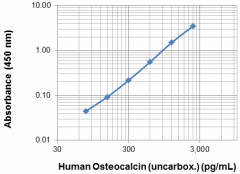- Regulatory Status
- RUO
- Other Names
- Osteocalcin, uncarboxylated osteocalcin, decarboxylated osteocalcin, 3xGlu, bone gamma-carboxyglutamate protein, Bone Gla Protein, BGP, OC, OCN, unOCN
- Ave. Rating
- Submit a Review
- Product Citations
- publications

| Cat # | Size | Price | Quantity Check Availability | Save | ||
|---|---|---|---|---|---|---|
| 446707 | 1 Pre-coated Plate | $578 | ||||
Osteocalcin is the most abundant non-collagenous protein found in the bone. It is produced by osteoblasts as a 49 amino acid protein, which contains 3 glutamine acid residues (Glu 17, 21, and 24) that are gamma carboxylated in a vitamin K dependent manner. While fully-carboxylated osteocalcin has a high affinity for the extracellular matrix of the bone; decreases in pH, caused by the process of bone resorption, result in decarboxylation of this protein. This generates both partially decarboxylated (undercarboxylated) and fully decarboxylated (uncarboxylated) osteocalcin molecules which are released into the circulation due to decreased affinity for the extracellular matrix.
Fully carboxylated osteocalcin requires high calcium concentrations for proper protein folding; however, under/uncarboxylated osteocalcin has no calcium requirement to maintain its structure within the blood. These under/uncarboxylated forms can bind the receptor GPCR6a and act as hormones promoting insulin sensitivity, glucose tolerance, and testosterone biosynthesis. In patients with diabetes, reduced serum levels of osteocalcin are negatively correlated with obesity and insulin resistance. Furthermore, supporting studies in mice have suggested potential therapeutic applications for osteocalcin in both obesity and insulin resistance.
BioLegend's LEGEND MAX™ Osteocalcin (uncarboxylated) ELISA kit is a Sandwich Enzyme-Linked Immunosorbent Assay (ELISA) with a 96-well strip plate that recognizes the uncarboxylated form of osteocalcin, allowing for specific study of this hormonal form of the protein. The plate is pre-coated with a monoclonal mouse capture antibody. The detection antibody is a biotinylated monoclonal mouse antibody. This kit is specifically designed for the accurate quantitation of human osteocalcin from cell culture supernatant, serum, plasma, and other biological fluids. It is analytically validated with ready-to-use reagents.
Kit Contents
- Kit Contents
-
- Anti-Human Osteocalcin Precoated 96-well Strip Microplate
- Human Osteocalcin Detection Antibody
- Human Osteocalcin Standard
- Avidin-HRP
- Assay Buffer B
- Wash Buffer (20X)
- Substrate Solution F
- Stop Solution
- Plate Sealers
Product Details
- Verified Reactivity
- Human
- Application
-
ELISA
- Product Citations
-
- Sensitivity
- 14.72 ± 5.0 pg/mL
- Standard Range
- 37.5 - 2400 pg/mL
- Materials Not Included
-
- Microplate reader able to measure absorbance at 450 nm
- Adjustable pipettes to measure volumes ranging from 1 µL to 1,000 µL
- Deionized water
- Wash bottle or automated microplate washer
- Log-Log graph paper or software for data analysis
- Polypropylene tubes to prepare standard dilutions
- Timer
- Plate Shaker
- Polypropylene vials
Antigen Details
- Molecular Family
- Hormones
- Gene ID
- NA
- UniProt
- View information about Uncarboxylated Osteocalcin on UniProt.org
Related Pages & Pathways
Pages
Related FAQs
- In your LEGEND MAX™ ELISA Kits, there is a step that calls for washing the plates before adding sample. What is the purpose of this step?
-
We typically use a stabilizer for pre-coated plates. The additional washing step is designed to remove these components before you start the assay. If you do not perform the washing, the effect on assay performance is negligible.
- I have multiple LEGEND MAX™ ELISA kits that I want to run simultaneously. Can I use the same wash buffer for all the kits?
-
The wash buffer provided in all our LEGEND MAX™ kits is the same and the part numbers on the wash buffer bottles in these kits should be identical. For ELISA MAX™ Deluxe and ELISA MAX™ Standard Sets, we provide a recipe for the wash buffer on each kit’s technical data sheet. This recipe is the same for all ELISA MAX™ sets.
- For some of your ELISA kits, why do my serum samples require dilution with assay buffer?
-
In some cases, dilution with assay buffer is required to minimize the matrix difference between the samples and the standards to achieve better accuracy.
 Login/Register
Login/Register 









Follow Us